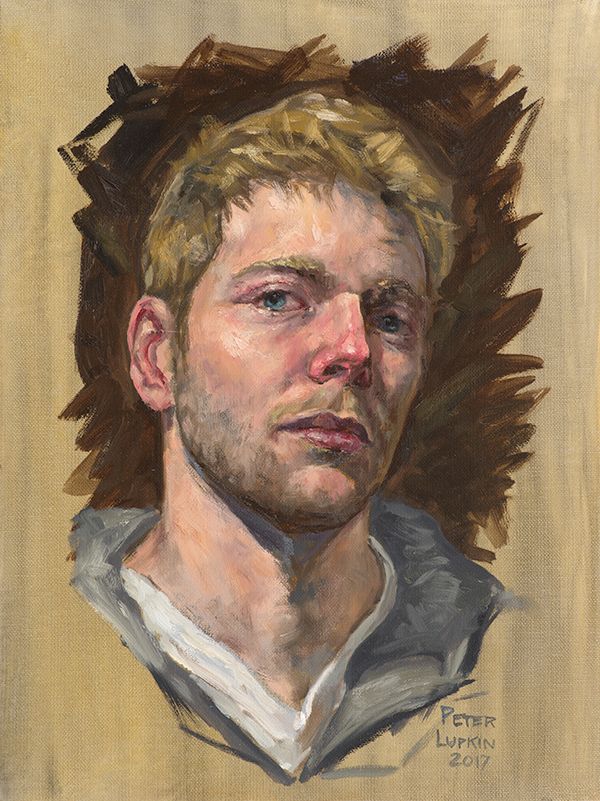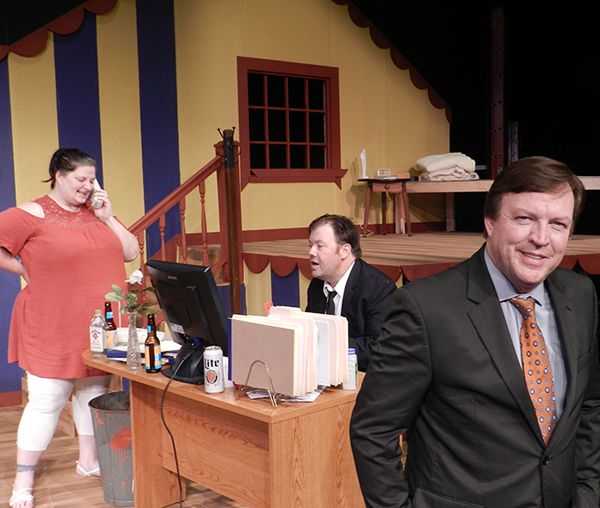When I walked into local oil painter Peter Lupkin’s in-home studio, I was bombarded in the best way by the number of paintings, both minuscule and massive. Just a quick scan of the space showed the talent of the painter and frequent traveler (fresh off the return from an engaging trip to Guatemala) and his consistency. This consistency and his skillful craftsmanship presents itself both in color, form and subject matter, all pouring forth from expertly-executed oil-based paintings. Admittedly there are some paintings that Lupkin doesn’t want anyone to see (but can’t bring himself to throw out) lining the walls while they sulk on the floor. These are vastly outnumbered by the vibrant, framed faces staring back.
“I abandon things sometimes. That’s why there are some things turned around out there,” said Lupkin during an interview in his kitchen while his cat Gaton meowed frequently, pining for attention.
What he hasn’t abandoned, however, is his day job and family business, William L. Lupkin Designs, which specializes in the creation and restoration of stained glass and mosaics. This is where Lupkin can express the more blue-collar side of artistry while retaining the finer side of creation.
“My full-time secondary job is painting. I’m going to be competing against some people who don’t have to work, and if they’re putting in 40 hours a week painting while I’m at my day job, it doesn’t really matter; it’s all about who produces more,” said Lupkin. “I love my day job. Even the restoration is enjoyable, knowing that it’ll be there until the next person needs to update it. At least I’m part of something this way.”
Once Lupkin overcame the initial hesitation that came with painting with oil and its heavy history, he jumped in head first, appreciating both the freeness he felt and the forgiveness the paint lent to his creations. This is a helpful tool, as Lupkin paints from life, specifically people, more often than not.
“I try to paint from life as much as I can. There are times I have to paint from a photograph, but with a trained eye you can always tell. I wouldn’t consider myself a classical realist or anything,” he said. “I try to just capture an emotion, something that tells a story through human emotion or experience. Being a figurative painter, human beings are the most infinitely interesting and fascinating subject in the world.”
Lupkin’s newest set of work, the Pyrrhic series, is based on the themes of a Pyrrhic victory: a victory that causes such a toll on the victor that the victory is actually more of a defeat.
“When I started thinking about this theme, I thought boxers were the ultimate image of this. Even if you’re someone as good as Muhammad Ali, you may win, but you get hit in the head so much that the worth of the whole thing is questionable. Everyone makes choices like that or goes through something similar just in their lives, but I thought boxers were such a good example and that it would be familiar and relatable enough,” he said.
Lupkin’s piece entitled “Pyrrhus” can transport you thoroughly into the boxer’s world of emotion and exertion. The look of exhaustion on the boxer’s face tells more about his most recent struggle than even he could in his own words. Even the bulging veins in his feet exemplify his body’s response and add that much more worth to the already expertly crafted oil on canvas painting.
Another straightforward example can be seen in “Pride,” also from the Pyrrhic series. The quiet smugness on the fighter’s face tells us all we need to know about the person, even if it’s just in that instance. Humans are constantly changing, expanding creatures, but in “Pride,” Lupkin has captured the one emotion this human was experiencing most and told the story via vibrant blues, smudged pinks and strong, rich reds where the boxer’s tension lies.
Working with models has its challenges, mostly financial and light-based ones. But when Lupkin is preparing his models and beginning the process, he is often surprised and grateful when the model makes a fortuitous, if unconscious choice on his or her own that pays off once a specific theme, emotion or example is set in stone.
“Each person holds themselves differently. I was working with a girl whose nervous tic was touching her ear when she was thinking. I had another original idea, but because that’s how she naturally acted it worked way better. It’s that way pretty regularly,” said Lupkin.
Another example can again be found within “Pyrrhus.” Lupkin was setting up different poses to see which worked best, and in between poses the subject for “Pyrrhus” relaxed on his own, creating a much better emotional scene than Lupkin was trying to stage.
“It was so much better because it was natural,” said Lupkin. “Sometimes you have to go through the process of setting things up to find something more instinctual and familiar to work from.”
Over a year ago Lupkin went through a stylistic change, becoming more aggressive both with the actual paint and the emotional subject matter, making his paintings less clinical. He moved away from using people as props as a means to an end and really began concentrating on the emotionality of the piece as a whole. This change helped Lupkin climb into the gallery realm fairly quickly.
Lupkin worked his way up and eventually became a featured artist at Gallery Victor Armendariz in Chicago, and he sells his work almost exclusively through them. Lupkin had been in communication through the years with Armendariz who picked up Lupkin and encouraged his newer stylistic tendencies when he took over the gallery. In the freelance world, if you’re lucky enough to establish yourself with a respected gallery, you don’t want to screw it up.
“Victor has given me such an opportunity and such freedom that I never want to mess that up. I really respect him, and I’m so lucky to be able to be showing where I am,” Lupkin said.
As my eyes wandered over the different portraits in Lupkin’s studio/living room, it was almost overwhelming how much talent was hiding there in plain view. If anyone deserves windows as walls, it’s Peter Lupkin. Maybe his models, laying nude on an antique couch or staring into the distance as they graze a cheek with their fingertips, would get nervous, but the chance to see Lupkin create such works of art would be worth it.
“I have the opportunity to create my own world, in its entirety,” said Lupkin. “It’s only my skill that can limit what I can do. That drives a lot of my passion. I am free.”



